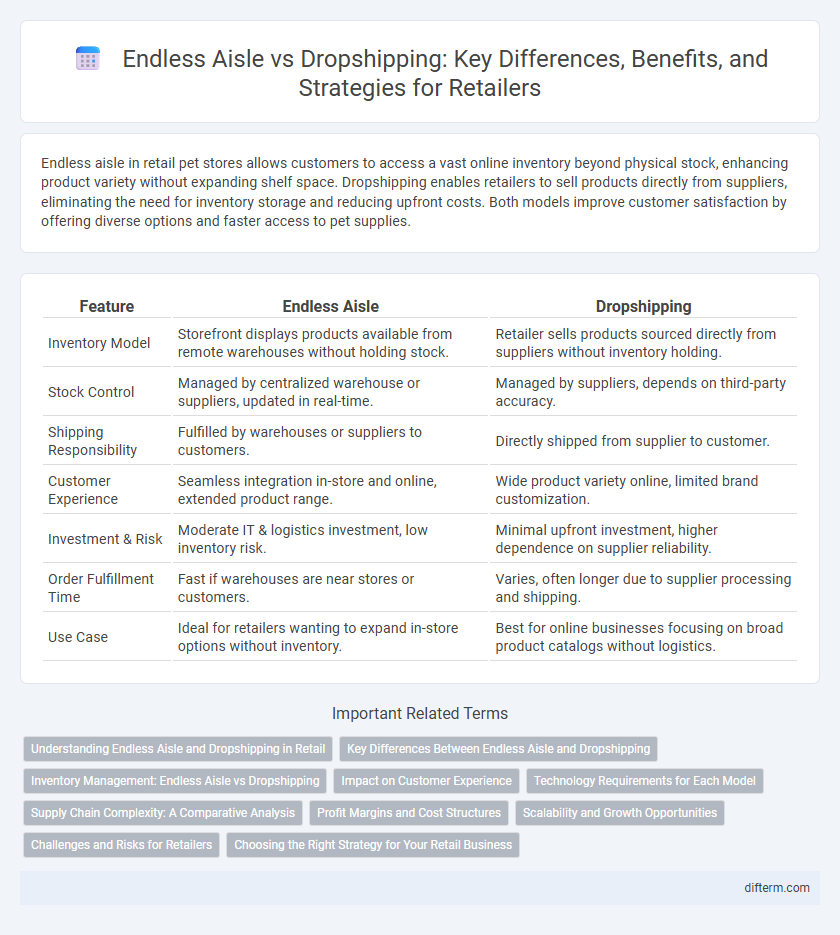Endless aisle in retail pet stores allows customers to access a vast online inventory beyond physical stock, enhancing product variety without expanding shelf space. Dropshipping enables retailers to sell products directly from suppliers, eliminating the need for inventory storage and reducing upfront costs. Both models improve customer satisfaction by offering diverse options and faster access to pet supplies.
Table of Comparison
| Feature | Endless Aisle | Dropshipping |
|---|---|---|
| Inventory Model | Storefront displays products available from remote warehouses without holding stock. | Retailer sells products sourced directly from suppliers without inventory holding. |
| Stock Control | Managed by centralized warehouse or suppliers, updated in real-time. | Managed by suppliers, depends on third-party accuracy. |
| Shipping Responsibility | Fulfilled by warehouses or suppliers to customers. | Directly shipped from supplier to customer. |
| Customer Experience | Seamless integration in-store and online, extended product range. | Wide product variety online, limited brand customization. |
| Investment & Risk | Moderate IT & logistics investment, low inventory risk. | Minimal upfront investment, higher dependence on supplier reliability. |
| Order Fulfillment Time | Fast if warehouses are near stores or customers. | Varies, often longer due to supplier processing and shipping. |
| Use Case | Ideal for retailers wanting to expand in-store options without inventory. | Best for online businesses focusing on broad product catalogs without logistics. |
Understanding Endless Aisle and Dropshipping in Retail
Endless Aisle in retail enables stores to offer customers access to a broader product range through digital displays without holding physical inventory, enhancing shopping experience and inventory management. Dropshipping involves retailers selling products directly from suppliers to customers, minimizing inventory risks by outsourcing fulfillment and shipping. Both models improve retail flexibility but differ in inventory control and supply chain dynamics.
Key Differences Between Endless Aisle and Dropshipping
Endless Aisle enables retailers to offer an expanded product catalog by displaying items available for online ordering directly within physical stores, enhancing customer experience without holding inventory. Dropshipping allows retailers to sell products they do not stock, with suppliers shipping items directly to customers, minimizing inventory risks and upfront costs. Key differences include inventory management, as Endless Aisle integrates in-store and online inventory visibility, while dropshipping relies entirely on third-party suppliers for fulfillment.
Inventory Management: Endless Aisle vs Dropshipping
Endless Aisle leverages centralized inventory management by integrating online and in-store stock, allowing retailers to offer a wider product range without physically stocking every item, thereby reducing storage costs and minimizing stockouts. Dropshipping relies on third-party suppliers who hold inventory and fulfill orders directly to customers, lowering retailer inventory risk but sacrificing control over stock accuracy and delivery times. Efficient inventory synchronization in Endless Aisle enhances real-time availability tracking, while dropshipping demands robust supplier coordination to prevent overselling or delayed shipments.
Impact on Customer Experience
Endless Aisle enhances customer experience by providing access to a vast inventory beyond store shelves, enabling immediate product discovery and purchase without wait times. Dropshipping impacts customer experience by extending product variety without inventory risk, but longer shipping delays and less control over fulfillment can lead to inconsistent delivery times and customer dissatisfaction. Retailers leveraging Endless Aisle create seamless omnichannel experiences, while dropshipping requires strong communication and logistics coordination to maintain customer trust.
Technology Requirements for Each Model
Endless Aisle technology requires advanced inventory management systems, real-time product catalogs, and integrated point-of-sale (POS) solutions to seamlessly connect physical stores with vast online warehouses. Dropshipping relies heavily on robust e-commerce platforms, automated order processing systems, and strong supplier integration via APIs to ensure timely product fulfillment without holding inventory. Both models demand reliable data synchronization and secure communication channels to maintain operational efficiency and customer satisfaction.
Supply Chain Complexity: A Comparative Analysis
Endless Aisle reduces supply chain complexity by integrating inventory visibility across multiple locations, enabling retailers to fulfill orders directly from warehouses or partner stores without holding excess stock. Dropshipping shifts inventory management responsibility to suppliers, simplifying retailer operations but increasing reliance on third-party logistics and creating potential delays in order fulfillment. Comparing both, Endless Aisle offers more control over product availability and shipping speed, while dropshipping provides scalable inventory options with less direct supply chain oversight.
Profit Margins and Cost Structures
Endless Aisle leverages existing inventory with lower upfront costs, resulting in higher profit margins due to reduced storage and logistics expenses, while dropshipping involves third-party fulfillment, often leading to thinner margins because of supplier fees and less control over shipping costs. Retailers using Endless Aisle benefit from better cost structures by minimizing overstock risks and optimizing inventory turnover. Dropshipping's variable costs and dependency on external suppliers can constrain profitability despite lower initial investments.
Scalability and Growth Opportunities
Endless aisle technology enhances scalability by integrating digital inventory with physical stores, allowing retailers to offer vast product selections without extensive warehouse expansion. Dropshipping supports growth opportunities by minimizing upfront inventory costs and enabling direct shipment from suppliers, facilitating rapid market entry and flexible product testing. Retailers aiming for scalable growth often combine endless aisle's customer experience benefits with dropshipping's cost efficiency for optimized omnichannel expansion.
Challenges and Risks for Retailers
Endless Aisle challenges for retailers include complex inventory management and potential customer dissatisfaction due to backorder delays, while dropshipping risks involve loss of control over product quality and shipping times, increasing the likelihood of returns and negative reviews. Retailers must also navigate supplier reliability issues and maintain consistent pricing strategies to protect brand reputation. Both models require robust integration with e-commerce platforms and vigilant monitoring to mitigate operational disruptions and ensure seamless customer experiences.
Choosing the Right Strategy for Your Retail Business
Endless aisle empowers retailers to offer products beyond physical inventory by leveraging suppliers' stock, enhancing customer choice without increased warehouse costs. Dropshipping eliminates inventory management, as products ship directly from suppliers, reducing upfront investment but potentially affecting delivery control and margins. Selecting between endless aisle and dropshipping depends on factors like inventory capabilities, customer experience priorities, and operational scalability.
Endless Aisle vs Dropshipping Infographic

 difterm.com
difterm.com